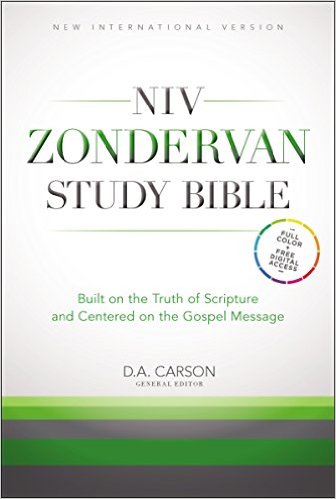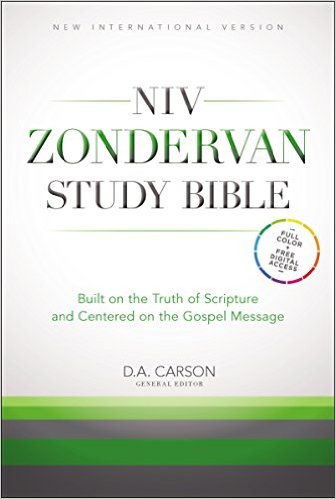NIV Zondervan Study Bible

A Denver Seminary Book Review by Denver Seminary Professor of New Testament William W. Klein

D. A. Carson, gen. ed. NIV Zondervan Study Bible. Grand Rapids: Zondervan, 2015. 2912 pp. $49.99. ISBN: 9780310438335.
How does one review a study Bible, and one that’s almost 3000 pages in length? Well, I guess the only option is to describe its features and give an assessment of how useful they appear to be for those who are its target readership. First, Dr. Carson of Trinity Evangelical Divinity School, is the general editor. Assisting him as associate editors are Richard S. Hess, Denver Seminary (Old Testament, archaeology, and maps), T. D. Alexander, Union Theological College (Old Testament and biblical theology), and Douglas J. Moo, Wheaton College (New Testament and biblical theology). Andrew David Naselli, Bethlehem College and Seminary, served as Assistant Editor. The editors have recruited a wide array of authors to contribute to the volume. Carson observes that “all our contributors revere Scripture as the Word of God and joyfully bow to its authority” (xxiii). These authors write introductions to major sections of the canon as well as introductions and notes to the biblical books. They also compose twenty-eight separate articles that appear at the end of the volume and that cover a variety of topics. As to the selection of these particular topics, Carson explains that they focus on questions of biblical theology (in distinction to systematic theology). He defines that task as “to highlight the way various themes develop within the Bible across time” (p. xxiii). He goes on, “Such biblical theology enables readers to follow the Bible’s themes in the terms and categories that the Bible itself uses.” One can always quibble with the choices, but the list appears to be a good one.
What other features will one find in this NIV Study Bible? After the introductions to each book–which includes discussions of the typical introductory issues, an outline of each book’s contents, and its major themes–one will discover lists of cross-references on each page, as well as extensive notes at the bottom of the pages. Pictures, maps, charts, and other graphics also appear on many pages, helping to illustrate the biblical text. The biblical text is divided into labeled sections, and where relevant, parallels to other books are noted at the beginning of each section (especially in Kings, Chronicles, and the Gospels, but also in other books). Hymnic material and poetry are inset in versified form, whereas normal prose is divided by paragraphs, all with superscripted verse numbers. The table of contents at the beginning exhibits the extensive list of the maps, charts, illustrations, and the articles. Finally, and obviously, this study Bible is based on the NIV, the current best seller among English translations.
The success of any study Bible is determined by how well it serves those who use it. Its considerable heft probably means that people won’t be carrying it with them to church into the pews (though I observe these days that fewer people do that anyway than was formerly the expectation). That said, it will serve well serious Bible students as the first place to go to secure the essential information they need. This substantial volume contains the useful maps, helpful charts, and many appealing pictures that one might hope for. In short, this volume is a one-stop shopping place that will answer most of the main and initial questions that Bible students have—whether in their own personal Bible study, church school class, or in small group setting. In comparison to the many others in this genre, this is the best on the market.
Of course, a study Bible has admitted limitations; after all, one book can’t do justice to the entire canon. The primary limitation resides in the introductions and the notes. Authors (and their editors) determine how much space they can give to these matters; they determine which topics they will address in the notes; and finally, they give their own interpretation of those issues (as do, of course, all commentators). Readers may well find the answer to a specific question they bring. On the other hand, the notes may not address it, and they will need to look elsewhere. Thus, those who want and need more help in their study will need to head to the standard commentaries (see the extensive lists for both the Old Testament and New Testament in each edition of the “Denver Journal“).
William W. Klein, Ph.D.
Professor of New Testament
Denver Seminary
April 2016
